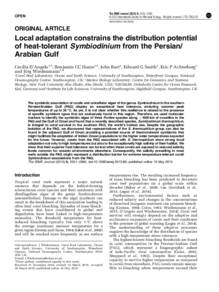Document
Local adaptation constrains the distribution potential of heat-tolerant Symbiodinium from the Persian/Arabian Gulf.
Identifier
DOI: 10.1038/ismej.2015.80
Contributors
Hume, Benjamin CC., Author
Burt, John., Author
Smith, Edward G., Author
Achterberg, Eric P., Author
Wiedenmann, Jörg., Author
Publisher
Nature Publishing Group.
Gregorian
2015-05
Language
English
English abstract
The symbiotic association of corals and unicellular algae of the genus Symbiodinium in the southern Persian/Arabian Gulf (PAG) display an exceptional heat tolerance, enduring summer peak temperatures of up to 36 °C. As yet, it is not clear whether this resilience is related to the presence of specific symbiont types that are exclusively found in this region. Therefore, we used molecular markers to identify the symbiotic algae of three Porites species along >1000 km of coastline in the PAG and the Gulf of Oman and found that a recently described species, Symbiodinium thermophilum, is integral to coral survival in the southern PAG, the world's hottest sea. Despite the geographic isolation of the PAG, we discovered that representatives of the S. thermophilum group can also be found in the adjacent Gulf of Oman providing a potential source of thermotolerant symbionts that might facilitate the adaptation of Indian Ocean populations to the higher water temperatures expected for the future. However, corals from the PAG associated with S. thermophilum show strong local adaptation not only to high temperatures but also to the exceptionally high salinity of their habitat. We show that their superior heat tolerance can be lost when these corals are exposed to reduced salinity levels common for oceanic environments elsewhere. Consequently, the salinity prevailing in most reefs outside the PAG might represent a distribution barrier for extreme temperature-tolerant coral/Symbiodinium associations from the PAG.
Member of
ISSN
1751-7362
Resource URL
Category
Journal articles

